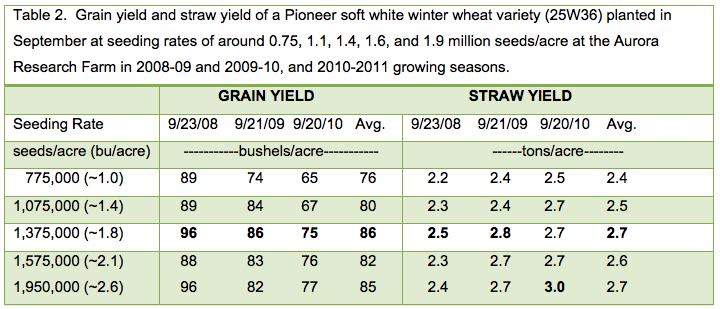Bill Cox1, Eric Sandsted2, and Phil Atkins3
1Soil and Crop Sciences Section, 2Horticulture Section – School of Integrated Plant Science; 3New York Seed Improvement Project – Cornell University
New York wheat producers harvest approximately 100,000 acres annually with average yields of 63 bushels/acre over the last 5 years. Although the crop has limited acreage compared with perennial forages, corn, or even soybeans in New York, the crop still averaged about $40M in value over the last 5 years. In addition, there is a strong demand for wheat straw, so the actual value of the crop exceeds $50M, making it a major New York agricultural commodity.
About 50% of wheat acres in New York are planted after soybean harvest, typically in mid to late October. The other 50% of wheat acres are planted after harvest of either vegetable crops (peas, green beans, sweet corn) or spring grains (oats and spring barley), typically in mid to late September because of the earlier harvest of these crops. More than 60% of the soybeans, 20% above the 5-year average, were planted in May this year. In addition, the dry conditions in August and during the half of September coupled with exceptionally warm September conditions has greatly accelerated the maturity of soybean. We expect half of the soybean acres to be harvested in September this year, which should result in about 75% of the wheat being planted in September in New York in 2015. This article will revisit a seeding rate study on two soft red winter wheat varieties (25R47 and 25R62) and a soft white winter wheat variety (25W36) planted on September 23 in 2008, September 21 in 2009, and September 20 in 2010 in central NY. Seeding rates evaluated included ~745,000, 1,030,000, 1,320,000, 1,510,000, and 1,875,000 seeds/acre, which corresponded to about 1.0, 1.4, 1.7, 2.0, and 2.5 bushels/acre, respectively. In addition, we will discuss a recent study on the soft white wheat variety, Medina, planted at 1.5, 2.0, and 2.5 bushels/acre planted on September 30 in 2014.
When averaged across the three growing seasons of the study, regression analyses indicated that 25R47 had maximum yield at ~1,320,000 seeds/acre, close to the recommended rate of 1,400,000 seeds/acre (Table 1). In contrast, 25R62 had a maximum yield at ~ 1,030,000 seeds/acre, about 400,000 seeds/acre less than the current recommended rate (Table 1). Furthermore, this variety did not respond to seeding rates in the last two years of this study.
Many growers in NY, however, also harvest wheat straw because of the strong demand by nearby dairy producers. In contrast to grain yields, straw yields of 25R47 and 25R62, when averaged across the three growing seasons, had maximum yield at ~1,510,000 seeds/acre, mainly because of the more positive response to seeding rates in the last two growing seasons (Table 1). The data indicate that current soft red winter wheat varieties planted in late September in NY exclusively for grain could be seeded as low as 1,000,000 and 1,300,000 seeds/acre, if growers do not harvest the straw and input costs are an issue. If wheat growers harvest the straw, however, seeding rates should remain at ~1.500,000 seeds/acre.
Seeding rates of soft white winter wheat varieties traditionally have been ~2 bushels/acre for a September planting date. The soft white winter wheat variety, 25W36, had maximum grain and straw yields at ~1,375,000 seeds/acre when averaged across the three growing seasons (Table 2). This corresponded to a seeding rate of about 1.8 bushel/acre, close to the recommended seeding rate. It is interesting to note that the soft white variety had a more consistent response to seeding rates across the three years than the two soft red varieties. In our 2014-2015, study, however, Median, a soft white winter wheat variety, did not respond to seeding rates with similar yields at 1.5, 2.0, and 2.5 bushels/acre (Table 3). Yields, however, were low in 2015 probably because of the late green-up (early April) after the very cold winter, the wet conditions in May (5.56 inches of precipitation), which probably resulted in loss of some top-dress N, and exceedingly wet June conditions (8.00 inches!), which resulted in significant head scab.
CONCLUSION
If NY wheat growers are marketing only the grain, seeding rates for soft red winter wheat varieties should range from ~1,000,000 to 1,300,000 seeds/acre, if planting the crop in mid to late September. If soft red winter wheat producers also harvest and market the straw, seeding rates should be ~1,500,000 seeds/acre for a September-planted crop. In 2010-2011, we did observe increased lodging at seeding rates above 1,375,000 seeds/acre, which probably contributed to the yield decline at the higher seeding rates for grain yields in the soft red winter varieties (although straw yields continued to increase). A soft white winter variety, 25W36, had mostly consistent maximum grain and straw yields at ~1,375,000 seeds/acre (~1.8 bushel/acre) across growing seasons so higher seeding rates are not required for September-planted wheat. In the very wet 2015 spring, grain yield of another soft white winter variety, Medina, did not respond to seeding rates above 1.5 bushels/acre. Although many NY wheat growers plant at greater than these recommended seeding rates, yields are seldom increased. In addition, the risk of lodging and disease pressure increases at higher seeding rates so growers should not pay a higher seed cost/acre to increase lodging and disease pressure if planting wheat in September this year.




